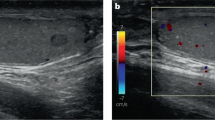Abstract
The association of testicular microlithiasis with testicular tumor and the management of incidentally detected testicular microlithiasis have generated a great deal of interest. We review the current literature on testicular microlithiasis with regard to its association with testicular tumor. This association seems complex. The available data suggest that men with incidental findings of testicular microlithiasis but who have otherwise normal testes are at low risk of developing testicular cancer. The only follow-up recommended is regular testicular self-examination. Testicular microlithiasis is, however, associated with a high risk of developing testicular malignancy in men with subfertility, history of contralateral testicular tumor or history of cryptorchidism. Regular testicular self-examination is recommended for follow-up of high-risk patients, but the role of surveillance with serial ultrasonography and measurement of tumor markers is still not clear.
Key Points
-
A strong association exists between testicular microlithiasis and testicular tumor, but no evidence suggests that testicular microlithiasis is premalignant in men with otherwise normal testes, who comprise a low-risk group
-
Low-risk patients with testicular microlithiasis are recommended to follow up the diagnosis with regular testicular self-examinations; serial ultrasonography, assessment of tumor markers and testicular biopsy are not warranted
-
Testicular microlithiasis in men with subfertility, history of contralateral testicular tumor and history of cryptorchidism is associated with an increased risk of having carcinoma in situ and developing testicular malignancy
-
Follow-up of patients with testicular microlithiasis, involving regular testicular self-examinations, is recommended for those at high-risk but serial ultrasonography, assessment of tumor markers and testicular biopsy do not seem to improve survival
This is a preview of subscription content, access via your institution
Access options
Subscribe to this journal
Receive 12 print issues and online access
$209.00 per year
only $17.42 per issue
Buy this article
- Purchase on Springer Link
- Instant access to full article PDF
Prices may be subject to local taxes which are calculated during checkout

Similar content being viewed by others
References
Priebe CJ Jr and Garret R (1970) Testicular calcification in a 4-year-old boy. Pediatrics 46: 785–788
Doherty FJ et al. (1987) Testicular microlithiasis: a unique sonographic appearance. J Ultrasound Med 6: 389–392
Bennett HF et al. (2001) Testicular microlithiasis: US follow-up. Radiology 218: 359–363
Backus ML et al. (1994) Testicular microlithiasis: imaging appearances and pathologic correlation. Radiology 192: 781–785
Cornud F et al. (2001) Ultrasound findings in male hypofertility and impotence. Eur Radiol 11: 2126–2136
Bieger RC et al. (1965) Testicular intratubular bodies. J Clin Endocrinol Metab 25: 1340–1346
Vegni-Talluri M et al. (1980) Testicular microliths: their origin and structure. J Urol 124: 105–107
Renshaw AA (1998) Testicular calcifications: incidence, histology and proposed pathological criteria for testicular microlithiasis. J Urol 160: 1625–1628
Peterson AC et al. (2001) The prevalence of testicular microlithiasis in an asymptomatic population of men 18 to 35 years old. J Urol 166: 2061–2064
Derogee M et al. (2001) Testicular microlithiasis, a premalignant condition: prevalence, histopathologic findings, and relation to testicular tumor. Urology 57: 1133–1137
Skyrme RJ et al. (2000) Testicular microlithiasis in a UK population: its incidence, associations and follow-up. BJU Int 86: 482–485
Cast JE et al. (2000) Testicular microlithiasis: prevalence and tumor risk in a population referred for scrotal sonography. AJR Am J Roentgenol 175: 1703–1706
Von Eckardstein S et al. (2001) Sonographic testicular microlithiasis as an indicator of premalignant conditions in normal and infertile men. J Androl 22: 818–824
Leenen AS and Riebel TW (2002) Testicular microlithiasis in children: sonographic features and clinical implications. Pediatr Radiol 32: 575–579
Miller NAC et al. (2007) Testicular calcification and microlithiasis: association with primary intra-testicular malignancy in 3,477 patients. Eur Radiol 17: 363–369
Ikinger U et al. (1982) Microcalcifications in testicular malignancy: diagnostic tool in occult tumor? Urology 19: 525–528
Ganem JP et al. (1999) Testicular microlithiasis is associated with testicular pathology. Urology 53: 209–213
Dieckmann KP et al. (1986) Bilateral testicular germ cell tumors. Report of nine cases and review of the literature. Cancer 57: 1254–1258
Holm M et al. (2003) Increased risk of carcinoma in situ in patients with testicular germ cell tumor with ultrasonic microlithiasis in the contralateral testicle. J Urol 170: 1163–1167
Skakkebaek NE et al. (1982) Carcinoma-in-situ of the undescended testis. Urol Clin North Am 9: 377–385
Bach AM et al. (2003) Is there an increased incidence of contralateral testicular cancer in patients with intratesticular microlithiasis? AJR Am J Roentgenol 180: 497–500
Pourbagher MA et al. (2005) Follow-up of testicular microlithiasis for subsequent testicular cancer development. Urol Int 74: 108–112
Furness PD III et al. (1998) Multi-institutional study of testicular microlithiasis in childhood: a benign or premalignant condition? J Urol 160: 1151–1154
McEniff N et al. (1995) Yolk sac tumor of the testis discovered on a routine annual sonogram in a boy with testicular microlithiasis. AJR Am J Roentgenol 164: 971–972
Winter TC III et al. (1996) Testicular carcinoma in a patient with previously demonstrated testicular microlithiasis. J Urol 155: 648
Frush DP et al. (1996) Testicular microlithiasis and subsequent development of metastatic germ cell tumor. AJR Am J Roentgenol 167: 889–890
Cornford PA et al. (2001) Testicular microlithiasis needs long-term surveillance. Scand J Urol Nephrol 35: 243–244
Ortiz Gorraiz MA et al. (2003) Testicular microlithiasis and testicular cancer [Spanish]. Arch Esp Urol 56: 521–524
Lawrentschuk N et al. (2003) Testicular microlithiasis: a case report and review of the literature. ANZ J Surg 73: 364–366
Thomas K et al. (2000) The incidence and significance of testicular microlithiasis in a subfertile population. Br J Radiol 73: 494–497
Sasagawa I et al. (1988) Testicular microlithiasis in male infertility. Urol Int 43: 368–369
Pierik FH et al. (1999) Is routine scrotal ultrasound advantageous in infertile men? J Urol 162: 1618–1620
Schantz A and Milsten R (1976) Testicular microlithiasis with sterility. Fertil Steril 27: 801–805
Moran JM et al. (1993) Idiopathic testicular microlithiasis: ultrastructural study. Br J Urol 72: 252–253
de Gouveia Brazao CA et al. (2004) Bilateral testicular microlithiasis predicts the presence of the precursor of testicular germ cell tumors in subfertile men. J Urol 171: 158–160
Husmann DA (2005) Cryptorchidism and its relationship to testicular neoplasia and microlithiasis. Urology 66: 424–426
Campbell HE (1959) The incidence of malignant growth of the undescended testicle: a reply and re-evaluation. J Urol 81: 663–668
Author information
Authors and Affiliations
Corresponding author
Ethics declarations
Competing interests
The authors declare no competing financial interests.
Rights and permissions
About this article
Cite this article
Jaganathan, K., Ahmed, S., Henderson, A. et al. Current management strategies for testicular microlithiasis. Nat Rev Urol 4, 492–497 (2007). https://doi.org/10.1038/ncpuro0856
Received:
Accepted:
Issue Date:
DOI: https://doi.org/10.1038/ncpuro0856
This article is cited by
-
Psychosocial impact of Peutz-Jeghers Syndrome
Familial Cancer (2009)



